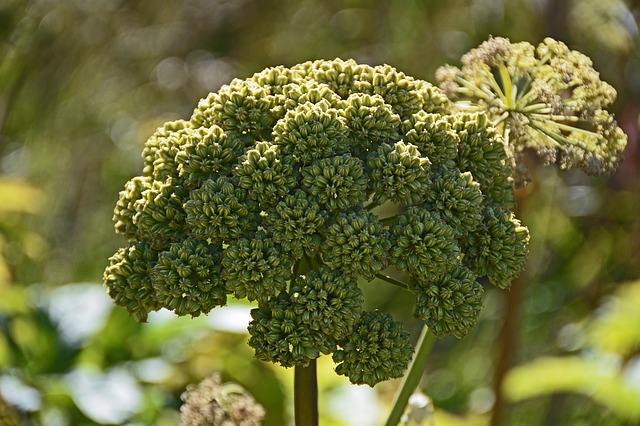 |  |  |  |  |
 |  |  |
Strong, biennial rarely perennial plant with a pleasant smell, it reaches 1-2.5 m in height. The rhizome is peg-shaped with lateral roots, it has a white, sometimes yellowish sap, which has a pleasant, sweet smell with a distinctly bitter taste. In the first year of life, only a rosette of root leaves is formed, in the second year a large, bare, hollow stem emerges from the rhizome. The stem branches at the top. Inflorescences shield-shaped, 8-15 cm in diameter. The plant blooms only in the second year of life, from June to August. The fruit ripens in September.
The root, less often the leaves and flowers are used for medicinal purposes. When collecting this plant, it is necessary to accurately determine its suitability, as there are more poisonous plants similar to it, as well as the forest bighorn beetle (Angelica sylvestris), which is often found in the territory of Latvia. Special attention should be paid to the condition of this plant, because a damaged plant cannot be used as a medicinal drug. The drug is harvested in late autumn in September-October, and the first year's plants are also dug. The plants of the second year are harvested in early spring in April-May. The roots of medicinal
garden Angelica
are shortened, shaken off from the soil and the surface part of the plant is cut off. Next, the rhizomes are washed in cold running water, cut and hung to dry. Rhizomes are hung to dry in well-ventilated rooms or forced dryers not exceeding 35-40C.
The leaves are collected during flowering and dried in well-ventilated rooms. The collected drug is stored in well-sealed cardboard boxes or bags for no longer than two years.
The root can also be used as a spice, then it is dug in the phase when the plant ripens its seeds. You can also collect inflorescences from one, haying them in bundles and drying them - in order to obtain plant seeds more easily. The seeds are completely dried on sieves. Dried rhizomes and seeds are stored in closed paper containers - especially rhizomes, because they easily absorb moisture and lose their aroma. As a spice, this plant gives a slightly bitter, slightly burning taste and a pleasant smell.
All parts of the plant contain an average of 1% essential oil. The basic composition of essential oils includes monoterpentines: phellandrene, pinene, barneol, cymol; terpenoids, coumarins (osthol, ostenol, umbelliprenin, xanthotoxin, imperatorin, angelicin, archangelicin, umbelliferone); phthalic acid derivatives: legustilide, sedanolide. Polyacetylene compounds found in
garden Angelica
oil: falcarinol, falcarindiol; coumarins: pinene, ostol and furocoumarins (angelicin, xanthotoxin, psolarene, bergapten, oxyoeucedanin); phytosterols, resin-6%, waxes, bitter substances and tannins, organic acids (malic, vinegar, angelic acid, valerian acid, etc.); sugar, pectins, carotene, starch. The fruit contains an average of 20% vegetable oil; in the leaves - ascorbic acid, calcium and phosphorus.
Medicinal significance
The medicinal value of the plant is determined by its biologically active substances. The essential oil has choleretic, diaphoretic, tonic, antispasmodic, analgesic, bactericidal, expectorant, diuretic properties, as well as it is capable of enhancing glandular secretion and motility of the digestive tract, reducing fermentation processes in the intestinal tract, normalizing the activity of the CNS, toning the cardiovascular system. system, and also increases bile secretion.
Bitter substances stimulate the appetite and have choleretic properties; tannins have astringent, anti-inflammatory, disinfecting, bacteriostatic, vasoconstricting, bactericidal properties. Tinnitus promotes expectoration, increases gastric secretion; coumarins have an antiseptic, astringent, diuretic effect; borneol, on the other hand, antispasmodic, pain reliever, antimicrobial, antipyretic, stimulant and anti-inflammatory. Furocoumarin has an antitumor effect.
Garden Angelica
also has phytoestrogenic and phytohormonal properties that can normalize a woman's hormonal background.
Garden Angelica
oil has a bactericidal and antispasmodic effect on the respiratory tract. The honey collected from this plant is also valuable.
In folk medicine, this plant has been known for a long time and is widely used since ancient times. It used to treat the effects of snake bites. Decoctions of
garden Angelica
root are used to treat liver and gall bladder diseases, as well as colds, bronchitis, laryngitis, neuroses, pneumonia and flatulence.
The above-ground part of the plant is used as an anthelmintic and to be used locally in rheumatism. A decoction of the roots is used as a stimulant, diaphoretic, diuretic, astringent, expectorant, anti-worm, tonic and strengthening agent.
The formulation is used orally in cases of bronchitis, bronchial asthma, epilepsy, hysteria, indigestion, dyspepsia, flatulence, inflammation of the respiratory tract, gastritis, colitis, cholecystitis, gallstones, inflammation of the pancreas, urinary retention, insomnia and "burning", as well as intestinal motility and secretions for activation. Externally, it is used for gout, rheumatism, toothache and earache. The plant extract can be used to rinse the oral cavity in case of various inflammations.
Garden Angelica
ointment is used to treat various skin diseases and festering scars. Garden Angelica
fruit preparations help to get rid of fever and increase the secretion of bile.
Typhoid, cholera, scarlet fever and measles are treated with flowers. This plant is included in Teriak*, it has been considered a universal remedy for many centuries.
* Universal antidote, which should cure everything, without excluding poisoning, including poisoning of the body caused by internal diseases. The ability to be an excellent preventative was also mentioned. Disappeared after the medieval period.
Originally named MITRIDACIUM.
If legends are to be believed, then the first theory was created during the reign of Emperor Mithridates VI Epatorus (120-63 BC), who was constantly worried about his poisoning.
In ancient Rome, the thearix was first compiled by Andromachus (court physician to Emperor Nero, 37-68 AD).
Theriax mixture for the poor - myrrh resin, laurel tree berries, aristolochia (pipe tree, Aristolochia clematitis L.), gentian (Gentiana cruciata L.)
